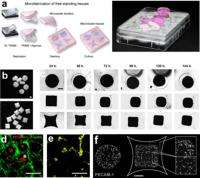Study finds an on-off switch for angiogenesis

Scientists from the MIRA and MESA+ research institutes at the University of Twente (The Netherlands) have discovered an ‘on/off switch’ for angiogenesis in human tissue. Their research has shown that the growth of new blood vessels can be controlled by using mechanical forces in cells. This discovery is an important step towards making the cultivation of new tissue, or even organs, possible. The researchers recently published their results in the leading scientific journal PNAS.
Many scientists are conducting research into cultivating tissues in labs. One potential application concerns reducing the need for donor organs. The chief advantage of artificially cultivated organs and tissue is that, in principle, they have unlimited availability and of course that there are no issues with organ rejection.
Scientists are already able to cultivate smaller pieces of tissue by using stem cells. However, to proceed to the next step in terms of size, it is important that the tissue be provided with blood vessels that can supply nutrients to all cells.
When growing tissue, scientists currently use growth factors, which are specific chemical substances that initiate cells to produce blood vessel tissue. The disadvantage of these growth factors is that they are expensive and that it is extremely complicated to control the angiogenesis process; you need a mixture of different growth factors and the timing and proportions of the mixture are crucial.
The University of Twente researchers have now found a more natural method to initiate the process of angiogenesis. They grew so-called mesenchymal stem cells and ‘blood vessel cells’ (endothelial cells) in various three-dimensional forms. The form in which the cell cultures grew proved to determine whether and where blood vessels grew. In forms with corners the cells moved further back in the corners than at the edges. This created internal mechanical tensions in the cell cultures. These mechanical tensions cause the cells to produce the appropriate growth factors and thus to initiate angiogenesis.
This gives researchers a method to initiate angiogenesis without administering growth factors, and this is not just relevant to cultivating tissue. Researchers also think that over time, this knowledge could be used in the battle against cancer, by inhibiting angiogenesis in the tumor’s immediate vicinity.
More information: ‘Tissue deformation spatially modulates VEGF signaling and angiogenesis’ PNAS (2012).
















